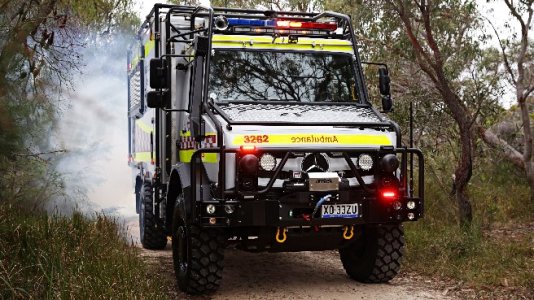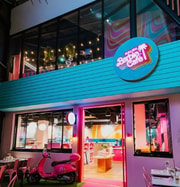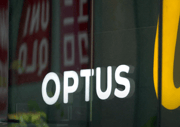Amazing Revelation: NSW's New Rescue Ambulances are Now Fire and Flood-Proof – See How They Can Save You in a Disaster!
By
Danielle F.
- Replies 1
In an era where climate change is making extreme weather events more common, New South Wales is stepping up its emergency response game with a fleet of mega ambulances designed to tackle the toughest of conditions. On Tuesday, the state unveiled its Hazardous Area Rescue Ambulances (HARAs), a world-first initiative that promises to revolutionize how medical aid is delivered during disasters.
These aren't your average ambulances. The HARAs are custom-built for offroad missions, capable of driving through floodwaters up to 1.2 meters high and are equipped with a fireproof exoskeleton that features a self-cooling system. This innovative design ensures that paramedics and patients alike are protected from the intense heat and flames that can arise during bushfires.
Health Minister Ryan Park expressed his pride in the new fleet, stating, 'This is the first of its type in the world used for an ambulance response, specifically in fire and in floods.' He emphasized the government's commitment to ensuring that frontline paramedics have the best tools available to deliver care in the most challenging and hazardous situations.
The fleet, which has been likened to 'Triple-0 monster trucks', includes eight of these robust vehicles that will be strategically stationed in high-risk disaster zones across Sydney and NSW, including places like Lismore, which have seen their fair share of natural calamities.
Previously, ambulance crews had to make do with what they had in disaster zones, often waiting for conditions to improve before they could safely reach patients. NSW Ambulance Commissioner Dominic Morgan highlighted the limitations of past responses, where ambulances had to be escorted by fire trucks to protect them from flames or rely on other agencies to transport patients through floodwaters.
The introduction of HARAs is a game-changer. With a price tag of $7.1 million for the eight vehicles, they are part of a broader $14.8 million strategy aimed at bolstering the state's disaster response capabilities. Minister Park acknowledged the need for such investment, noting that 'for many years to come, there’ll be more urgent and more climatic weather conditions that we have to respond to.'
While the ride in a HARA might be bumpy, Commissioner Morgan assures that for those caught in the midst of a flood or fire, the priority is to get to safety as quickly as possible. These ambulances are built to do just that, ensuring that even in the most dire circumstances, help is on the way.
The deployment of these ambulances is a testament to NSW's proactive approach to disaster management and patient care. It's a reassuring thought for residents that, should disaster strike, these 'Triple-0 monster trucks' are ready to brave the elements and provide life-saving assistance.

Members, we'd love to hear your thoughts on this innovative approach to emergency healthcare. Do you feel more secure knowing that these vehicles are out there? Have you or someone you know ever been in a situation where a HARA could have made a difference? Share your stories and opinions in the comments below, and let's discuss the future of disaster response in our communities.
These aren't your average ambulances. The HARAs are custom-built for offroad missions, capable of driving through floodwaters up to 1.2 meters high and are equipped with a fireproof exoskeleton that features a self-cooling system. This innovative design ensures that paramedics and patients alike are protected from the intense heat and flames that can arise during bushfires.
Health Minister Ryan Park expressed his pride in the new fleet, stating, 'This is the first of its type in the world used for an ambulance response, specifically in fire and in floods.' He emphasized the government's commitment to ensuring that frontline paramedics have the best tools available to deliver care in the most challenging and hazardous situations.
The fleet, which has been likened to 'Triple-0 monster trucks', includes eight of these robust vehicles that will be strategically stationed in high-risk disaster zones across Sydney and NSW, including places like Lismore, which have seen their fair share of natural calamities.
Previously, ambulance crews had to make do with what they had in disaster zones, often waiting for conditions to improve before they could safely reach patients. NSW Ambulance Commissioner Dominic Morgan highlighted the limitations of past responses, where ambulances had to be escorted by fire trucks to protect them from flames or rely on other agencies to transport patients through floodwaters.
The introduction of HARAs is a game-changer. With a price tag of $7.1 million for the eight vehicles, they are part of a broader $14.8 million strategy aimed at bolstering the state's disaster response capabilities. Minister Park acknowledged the need for such investment, noting that 'for many years to come, there’ll be more urgent and more climatic weather conditions that we have to respond to.'
While the ride in a HARA might be bumpy, Commissioner Morgan assures that for those caught in the midst of a flood or fire, the priority is to get to safety as quickly as possible. These ambulances are built to do just that, ensuring that even in the most dire circumstances, help is on the way.
The deployment of these ambulances is a testament to NSW's proactive approach to disaster management and patient care. It's a reassuring thought for residents that, should disaster strike, these 'Triple-0 monster trucks' are ready to brave the elements and provide life-saving assistance.
Key Takeaways
- NSW has unveiled a fleet of Hazardous Area Rescue Ambulances (HARAs) designed for offroad disaster missions.
- The HARAs can drive through 1.2m-high floodwaters, are fireproof, and feature a self-cooling exoskeleton.
- Eight vehicles will be deployed in Sydney and across NSW, particularly in high-risk disaster zones such as Lismore.
- The rollout of these rescue ambulances is part of a $14.8 million strategy to enhance the state's disaster response capabilities.








